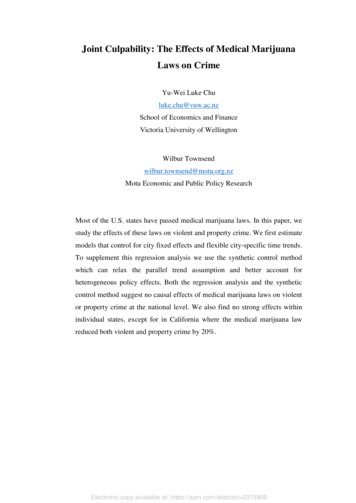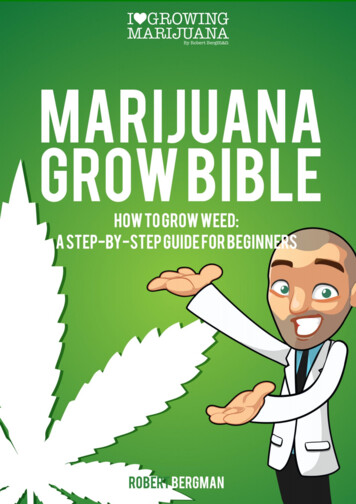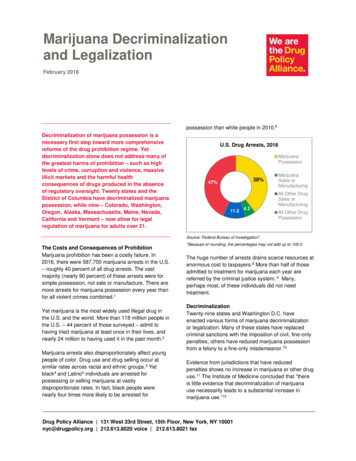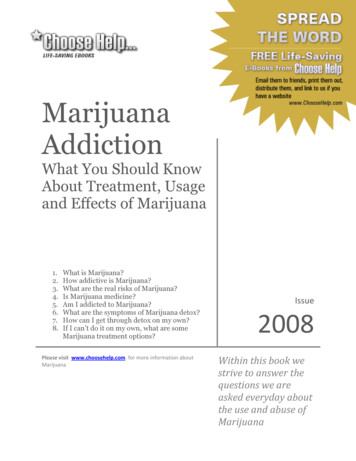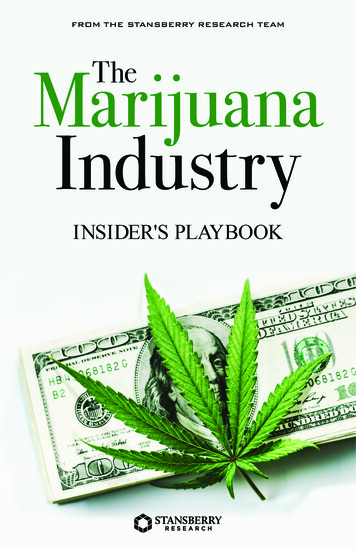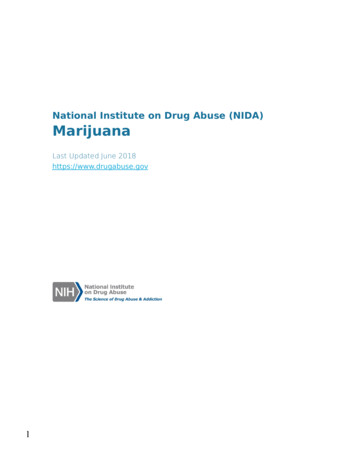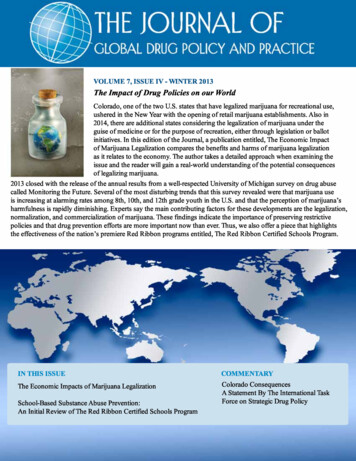
Transcription
THE ECONOMIC IMPACTS OF MARIJUANA LEGALIZATIONBy: David G. Evans, Esq., Executive Director, Drug Free Projects CoalitionThis is the first of a series of papers exploring the economic and social costs of legalizing marijuana. Thestates of Washington and Colorado in the United Sates have legalized marijuana for recreational use. Anumber of other states have legalized crude marijuana for “medical” use. As these experiments go on,there will be more data to be recorded, analyzed and published. Our research will continue as to theimpact of marijuana legalization and future papers will explore this new data. Future papers will focus onspecific economic issues relating to marijuana legalization. For example, papers will be published thatwill explore in more detail the environmental, medical, criminal, spiritual, productivity and other socialcosts of legalization.This paper will discuss the general economic and social arguments for legalizing marijuana then we willexplore the general economic and social arguments against it. Finally, we will discuss the economic andsocial damage caused by “medical” marijuana. The “medical” marijuana argument is presented separatelybecause some people, who do not favor legalization of marijuana for recreational purposes, favor its legalstatus as medicine.While the public health, safety, and productivity implications of marijuana use are amply documented,their dollar value has not been completely assessed to date.
A. The pro-marijuana argument - the direct economic benefits of legalizing marijuanaoutweigh the costsThe marijuana legalization advocates have argued that whether the direct costs of legalization areoutweighed by economic benefits depends on the following economic concerns: (a) estimated savingsfrom reduced spending on the criminal justice costs of marijuana law enforcement and revenue lossesfrom shifts in law enforcement policies; (b) projected revenues from additional taxes and streams ofincome; ( c) immediate and projected expenditures to address the known harms of marijuana use and toimplement and enforce policy reforms.Budgetary savingsCriminal justice budgets typically do not list the costs of enforcing particular drugs laws, however,Harvard economist Jeffrey Miron has written a series of policy papers estimating various governmentexpenditures associated with marijuana criminalization (1). According to Miron, legalization will reducethe need for prosecutorial, judicial, correctional, and police resource spending by approximately 7.7billion – 13.7 billion per year, (2) even though some revenue from court fines and asset forfeitureswould be lost (3). Miron claims his estimates can be verified empirically and his calculations are adjustedfor economic inflation and growth in enforcement spending over the past decade (4). Accordingly, Mironis cited to argue for a cost-minimizing approach to criminal justice (5).Revenue gainsAlthough marijuana advocates claim that marijuana taxation, licensing, and industry could generate morethan 8.7 billion in government revenue, (6) the value of gains cannot be gauged at this time becauserevenues from licensing and industry vary by state (7). Additionally, tax revenue projections areinherently uncertain because they rely on questionable assumptions about the unknown impact of blackmarket supply on consumer demand in regulated markets.
Tax expert and attorney Pat Oglesby conducted an analysis of existing marijuana tax proposals (8).Oglesby claims that Washington State’s legalization proposal (Initiative 502), which includes restrictionson advertising and drugged driving and has three distinct excise taxes, could generate approximately 500million in state revenue (9). Oglesby also acknowledges the possibility that Colorado’s taxation schemecould generate between 47 million and 100 million in revenue, (10) but he concludes the projectionsare completely unreliable because the state’s regulatory framework is fundamentally flawed (11).Finally, he finds Oregon’s plan (Measure 80) created a conflict of interest because “medical” marijuana issold privately at cost but under the legalization plan marijuana would be sold at a controlled cost, thoughhe admits money can be made under a state-controlled marijuana monopoly (12). Voters in Oregonrejected the plan. Finally, Oglesby notes that the economic impact of legalization depends on variousother factors that cannot be assessed at this time, including the possible emergence of new jobs, thelikelihood of tax evasion, and legalization’s probable impact on alcohol consumption (13).New expendituresAdding to the direct costs of implementing policy reforms, legalization will cause consumption ofmarijuana to increase, and this increase will have direct economic costs in terms of healthcare, socialservices and criminal justice (14).The magnitude and cost of increased consumption can be predictedby estimating supply and demand, but historical data from local marijuana markets does not exist, anddata from foreign markets fails to reflect the influence of local mores and cultural norms on consumerbehavior.Existing projections of growth in marijuana demand are based on consumption patterns in the Netherlandsand other regulated foreign markets, (15) where sufficient data exists to derive marijuana’s “demandelasticity”, e.g., the responsiveness of consumption rates to changes in price (16). To date, economists’best estimates of the increase in consumption range from 75%-289% but these estimates fail to account
for untested and novel pricing and taxation schemes, the underreporting of current marijuana use, or theimpact of social influences on consumption (17).While dependency is a known harm of marijuana consumption that will proliferate with increases inconsumption, the costs of marijuana treatment admissions may decline with legalization since the vastmajority of admissions have historically been referrals from the criminal justice system (18). Nationalhealthcare expenditures related to marijuana consumption are not known, but it estimated that marijuanadependency accounts for approximately 1/5 of all addiction treatment center admissions (19).Legalization will entail additional spending to update and enforce drugged driving regulations becausethere is evidence that consuming marijuana before driving doubles the chances of collision (20).Instates with per se drugged driving laws, court costs may also increase on account of due process issuesraised by the presumption that the presence of marijuana metabolites in one’s blood stream are evidenceof intoxication (21). Other court and law enforcement costs may also rise due to the shift in drugenforcement spending to tax enforcement spending (22).Indirect Economic Benefits of Legalizing Marijuana Outweigh Costs?Whether the indirect economic benefits of legalization will be great enough to offset the socioeconomiccosts of current policies depends on the following financial, political and human capital factors: (a)productivity losses from workplace accidents and employee absenteeism related to marijuanadependency; (b) productivity gains from anticipated reductions in the rates of unemployment, employeeturnover and absenteeism related to involvement with the criminal justice system; ( c) value ofimprovements in family stability and socioeconomic mobility within underprivileged communities due tothe reduction in incarcerations and disqualifying collateral consequences; (d) increases in addiction; (f) arise in health care costs including mental health; (g) increases in crime due to expanded marijuana use; (h)
reduction of learning capacity in students; (i) increases in drugged driving.Productivity lossesThe marijuana advocates claim that research regarding the impact of marijuana use on job performance isinconclusive, as marijuana’s performance effects vary by job task and among users based on the settingand frequency of use as well as the user’s personal characteristics and motivation to perform (23).Similarly, they claim the connection between absenteeism or workplace accidents and marijuana use maybe tenuous because research has not firmly established a causal nexus (24). Moreover, productivity lossesmay be negligible to the extent that the vast majority of marijuana consumers, like alcohol consumers, donot go to work intoxicated and instead reserve revelry for weeknights or weekends or other occasions thatwould not interfere with their work responsibilities.Productivity gainsCrime statistics indicate that marijuana offenses account for almost half of the 1,531,251 drug arrestsnationwide, and that nearly 9 out of every 10 marijuana arrests are for possession, not distribution (25).However, marijuana offenders convicted of possession account for only two-tenths of one percent (.2%)of federal inmates and just one-tenth of one percent (0.1%) of state prisoners without a prior criminalrecord (26). Often, incarceration is due to probation or parole violations or for possession of wholesalequantities where intent to distribute could not be proved (27). Reducing the number of marijuana-relatedarrests and incarcerations may cause marginal growth in aggregate productivity as fewer employees whoalready have jobs will need to miss work for required court appearances, and incarcerated offenders willbe able to participate in the job market (28). Additional gains in productivity can be expected amongworkers who are raising children alone due to the incarceration of a spouse, whose return from prison willpermit child-rearing responsibilities to be shared between both parents, reducing the number of work daysmissed (29).
Socioeconomic improvementsThere is ample evidence of socioeconomic and racial disparities among those who are charged withmarijuana crimes and those who are actually convicted (30). The effect of fines, asset seizures, legal fees,required court appearances and missed work days is especially burdensome for marijuana defendantsfrom disadvantaged communities (31). Even if there is only a modest budgetary benefit from eliminatingthese features of our criminal justice system, (32) the marijuana advocates claim that it will helpdisadvantaged communities by reducing the criminalization of the underprivileged classes, mendingbroken homes, promoting upward social mobility, and reducing the collateral consequences of existingdrug enforcement policies (33).The arguments for legalization raise more questions than answers.B. The economic and social arguments against legalization of marijuanaThis report will now examine the efficacy of measures that legalize marijuana and the instances in whichthe present and long-term fiscal costs of legalization exceed tax revenue from marijuana.Although it is not necessarily improper to tax goods and services that harm consumers, marijuana’s legalstatus and social effects render taxation problematic. There may be significant and questionabledisparities between projected and actual tax revenues due to variation in regional demand for marijuana,future demand for taxable marijuana, revenue allocation among levels of government, and regulatorycompliance and enforcement. In many instances, the public expense of implementing and enforcingtaxation compounds the aggregate cost of marijuana’s negative effects on health, safety, and productivity.On the other hand, the research on legalization predicts a reduction in criminal justice costs, though lawenforcement budgets are more likely to remain substantially intact.
A survey of available research regarding the fiscal impact of marijuana found a number of economicanalyses that address the fiscal costs associated with existing laws but none that address the costs oflegalization. Because the data required for a formal cost-benefit analysis is not available at this time,invoking fiscal rhetoric to advance the legalization agenda is not merely irresponsible, it is also deceitful.In effect, it defies transparency, misdirects public debate, and belies a corporate purpose to privatizeprofits and socialize losses, subordinating the interests of taxpayers to those of the marijuana industry.OverviewRecent estimates of legalization’s impact on government spending predict possible savings and revenuesbut do not reflect the economic costs of departing from current policy. The true fiscal impact will dependon the costs generated by repealing current laws, plus the costs of implementing and enforcing proposedreforms, minus any tax revenues and savings that might accrue.Repealing current laws will generate additional costs due to consequences stemming from the increase inmarijuana use, abuse, and dependence. Implementing and enforcing reforms will require up-frontspending to establish a regulatory framework and on-going spending to collect taxes, regulate retailersand distributors, and protect users and non-users alike.Even if it is not possible to estimate these additional costs at this time, it is remiss to ignore them.Accordingly, the present and post-legalization effects of marijuana use must be examined to gain anunderstanding of their economic impact.Known Harms of Marijuana UseWhile the public health, safety, and productivity implications of marijuana use are amply documented,
their dollar value has not been completely assessed to date (34).Impact on Public HealthA number of studies have noted significant correlations between marijuana use and many severe healthand social problems (35). The negative impact of expanded marijuana use will have a severe andpervasive impact on public health from which there will be no turning back. Studies show impacts frommarijuana use such as immune system damage, (36) birth defects, (37) infertility, (38) cardiovasculardisease, (39) stroke, (40) and testicular cancer (41). Researchers have also found that chronic exposure tomarijuana smoke can increase the risk of developing respiratory obstruction, emphysema, lung cancer,collapsed lungs, and bullous lung disease ("bong lung") (42). A recent study shows that marijuana smokehas ammonia levels 20 times higher than tobacco smoke. Marijuana has hydrogen cyanide, nitric oxide,and aromatic amines at 3-5 times higher than tobacco smoke (43).Another study shows that that marijuana smokers face rapid lung destruction - as much as 20 years aheadof tobacco smokers (44). A recently released study shows that marijuana damages DNA and that it istoxic to the body (45).Marijuana hurts the immune systemOne of the earliest findings in marijuana research was the effect on various immune functions. Cellularimmunity and pulmonary immunity are impaired, and an impaired ability to fight infection is nowdocumented in humans. Researchers have found an inability to fight herpes infections and a bluntedresponse to therapy for genital warts in patients who consume marijuana. Abnormal immune function isthe cornerstone of problems with AIDS. This impairment leaves the patient unable to fight certaininfections and fatal diseases. The potential for these complications exists in all forms of administration ofmarijuana (46).
Marijuana is addictiveClinical dependence has been found to afflict roughly 10% of all marijuana users (47). Most are in theirlate teens and twenties (48).The risk of dependence is higher among those who try marijuana at a young age (49). In 2009,individuals between the ages of 12 and 25 comprised 65.3% of all substance abuse treatment admissionsfor marijuana; daily use was reported by 49.6% of this group (50).According to the 2010 National Survey on Drug Use and Health, the number of Americans who usedmarijuana increased from 14.4 million to 17.4 million between 2007 and 2010.The prevalence ofpast-year drug dependence or abuse among marijuana users (4.5 million) was found to exceed thecombined total for users of pain relievers (1.9 million) or cocaine (1 million). More unemployed adults(17.5%) used marijuana than those who worked full-time (8.4%) or part-time (11.2%). Clinicaldependence or abuse was also higher among unemployed adults (15.7%) than among part-time workers(10.9%) or full-time workers (8.9%). Lower rates of dependence and abuse were found among individualswho graduated from college (7.3%) than those who completed high school only (8%) or those who didnot complete high school (10.2 percent) (51).Marijuana is an addictive drug that poses significant health consequences to its users, including those whomay be using it for “medical” purposes. More young people are being treated for marijuana dependencethan for any other drug. Marijuana is far more powerful today than it was 30 years ago and it serves as aan entry point for the use of other illegal drugs. This is known as the “gateway effect.” Despite argumentsfrom the marijuana advocates to the contrary, marijuana is addictive. Unlike those addicted to many otherdrugs, the marijuana addict is exceptionally slow to recognize the addiction. This addiction has been well
described in the marijuana literature and it consists of both a physical dependence (tolerance andsubsequent withdrawal) and a psychological habituation (52).Mental healthMarijuana use may trigger psychiatric illnesses including mood disorder, latent schizophrenia, andclinical dependence. The American Psychiatric Association Position Statement on Marijuana as Medicinestates: “There is no current scientific evidence that marijuana is in any way beneficial for the treatment ofany psychiatric disorder. In contrast, current evidence supports, at minimum, a strong association ofcannabis use with the onset of psychiatric disorders. Adolescents are particularly vulnerable to harm,given the effects of cannabis on neurological development.” (53)Impact on Public SafetyStudies also shed light on marijuana’s implications for public safety. Short-term and long-term use areknown to cause cognitive impairment affecting sensorimotor functioning, attention span, memory,self-control, learning, and educational attainment (54).Sensorimotor and attentional deficits undermine users’ ability to safely engage in complex tasks likeoperating a motor vehicle or other heavy machinery. Studies have found that drivers under the influenceof marijuana typically exhibit reduced reaction speed, frequent lane-weaving, and they are twice as likelyas unimpaired drivers to be involved in traffic accidents (55). Using marijuana before driving has beenfound to increase the risk of fatal outcomes in motor vehicle collisions (56). Research on workplaceinjuries confirms these findings; employees who are impaired by the effects of marijuana are more likelyto be involved in accidents at work (57).In addition to its short-term effects on sensory perception, marijuana use can impair decision-making and
self-control during and long after intoxication. Known colloquially as ‘good judgment,’ self-control isgenerally believed to improve from youth into adulthood and to degenerate with substance abuse anddependence. Self control inhibits risk-seeking and impulsive behaviors that limit educational attainmentand contribute to criminal conduct. Economists, criminologists, and medical researchers have studied anddocumented these effects (58). According to one study, “the probability of being arrested for a non-druginvolved violent, property and income-producing crime” is greater for marijuana users than non-users(59).Impact on ProductivityMarijuana-impaired workers contribute to a decrease in productivity due to employee turnover,absenteeism, and illness. While performance effects might vary according to job task, frequency of use,and users’ personal characteristics, studies have found marijuana and alcohol pose comparable risks toproductivity (60).Employees who tested positive for marijuana had 55% more industrial accidents and 85% more injuriescompared to those that tested negative on a pre-employment exam and they had absenteeism rates 75%higher than those that tested negative (61).Low-income groups and minorities may be particularly vulnerable to the unintended effects oflegalization. According to one analysis, social stigma surrounding marijuana use could deepen the dividebetween managerial employees and rank-and-file workers:“[Marijuana use] does impair them as far as managerial favor, raises, promotions, and the like. Indirecteffects such as these could severely inhibit the workforce and overall production of minority groups, bystunting their ability to move up the chain of responsibility and command. Further complicating this is the
fact that with the legalization of marijuana, individuals would have less incentive to hide their habit,making it all the more easier to suffer remaining stigmatizing social consequences. Compounding theproblem is that in the legalized world ‘[e]ach new user would be at some risk of progressing to heavy,chronic use . . . .’” (62)Impact on Public BudgetsIn 2011, the National Drug Intelligence Center released a report that assessed 193 billion in annuallosses due to illnesses, accidents, lost productivity, and crime resulting from illicit drug use (63). Whilethe report did not separate marijuana from other drugs, it attributed nearly two-thirds of the losses to theimpact of drug use on productivity. The costs of property crime and homicides were roughly equivalent.An earlier study conducted by the National Center on Addiction and Substance Abuse at ColumbiaUniversity noted that “governmental spending is skewed toward shoveling up the burden of our continuedfailure to prevent and treat the problem rather than toward investing in cost effective approaches toprevent and minimize the disease and its consequences.” The study estimated that, in 2005, 467.7 billionwas spent on substance abuse addiction by federal ( 238.2 billion), state ( 135.8 billion), and local ( 93.8billion) governments. It found less than 3% of spending was related to prevention but more thanthree-fifths was due to healthcare costs, including those attributable to alcohol and tobacco use (64).Economic Consequences of LegalizationIn effect, legalization endorses marijuana as socially acceptable. It eliminates criminal penalties, reducingprices, increasing availability, and de-stigmatizing use (65). More likely than not, these consequences areirreversible:“Legalization would reduce the costs of supplying drugs by more than taxes could offset, pushing retail
prices into uncharted waters. We can be confident this would affect consumption; we just don’t know byhow much. One might consider giving legalization a trial run, pledging to repeal it if consumption endedup rising more than anticipated. However, even temporary legalization could have permanentconsequences. Society could certainly ‘unlegalize’ and reimpose prohibition, but that would not returnmatters to the status quo ex ante any more than putting toast in the freezer would change it back into freshbread.” (66)Economists estimate that marijuana use will increase by 75% - 289% once legalized, or more ifadvertising is permitted. However, the higher end of this range is probably more accurate because currentusage is underreported by 20%-40%. (67). According to the 2010 National Survey on Drug Use andHealth, 17.4 million Americans used marijuana in 2010. Legalization could thus invite between 13.05million and 47.85 million new users (68).Increase in Marijuana-related Healthcare CostsInevitably, the increase in use will correspond to an uptick in incidents of dependence and abuse. If thenumber of new users is between 13.05 million and 47.85 million, then treatment admissions would likelyincrease from 1.3 million to 4.8 million respectively. These estimates assume a dependence rate of only10%.Non-dependent users are still more prone to illnesses, accidents, and crime than non-users. Sincelegalization is expected to cut marijuana prices in half, making it more affordable, the drop in marketprices will compound risks for users who are young, poor, or already addicted (69). As a consequence,medical providers may need to adapt to the influx of new users who are involved in accidents or whoreport marijuana-induced panic attacks or dependence (70). While Medicaid and other public assistanceprograms currently pay for nearly two-thirds of all inpatient admissions, this share is expected to increase
under the Affordable Care Act, with or without legalization (71).Negative Impact on YouthA study examined early initiation into marijuana use and found, “the negative impact of marijuana use inthe tenth grade on educational attainment is similar in magnitude to the effect of living in a single parentfamily or living in a family with an income in the lowest quartile.” (72)Legalization will increase marijuana use. This will apply to young people. Marijuana can cause disinterestin activities, lower grades and isolation from the family. It can permanently impair brain development.Problem solving, concentration, motivation and memory are negatively affected. Teens who usemarijuana are more likely to engage in delinquent and dangerous behavior and experience increased riskof schizophrenia and depression including being three times more likely to have suicidal thoughts (73).Our drug treatment facilities are full of young people dealing with marijuana related problems. One studyof children in treatment showed that, 48% were admitted for abuse or addiction to marijuana, while only19.3 % for alcohol and 2.9 % for cocaine, 2.4 % for methamphetamine and 2.3 % for heroin (74).Marijuana use accounts for tens of thousands of marijuana related complaints at emergency roomsthroughout the United States each year. Over 99,000 are young people (75).As many as 13 % of high school seniors said they drove after using marijuana while only 10 % droveafter having five or more drinks. Vehicle accidents are the leading cause of death among those aged 15 to20 (76).A study of high school students showed that about 28,000 seniors each year admitted that they were in at
least one accident after using marijuana (77).Criminal Justice CostsIn spite of legalization, crime is endemic and will not diminish even though the kinds of crimescommitted might change. In fact, under a heavily regulated legalization regime, police detentions formarijuana-related offenses may dwarf the current rate.Legalization will increase drugged driving and more drugged driving will mean more dead and injureddrivers and other innocent victims and all the cost related to these tragedies (78).Marijuana significantly impairs the ability to safely operate a motor vehicle. Driving problems include:decreased handling performance, inability to maintain headway, impaired time and distance estimation,increased reaction times, sleepiness, impaired sustained vigilance and lack of motor coordination (79).Marijuana is the most prevalent drug found in fatally injured drivers testing positive for drugs (80).Under our current laws few offenders are in prison for marijuana possession. No more than two-tenths ofone percent (.2%) of federal inmates are locked up for marijuana possession and, among state prisoners,only one-tenth of one percent (0.1%) are in for marijuana possession without a prior record (81).Predictably, most of these prisoners are charged with probation or parole violations or with possession ofwholesale quantities where intent to distribute could not be proved.The proponents of legalization ignore the fact that legal sanctions deter or delay potential abusers, therebylimiting the growth of the illicit market. Law enforcement also leverages drug users/addicts into treatmentthrough the use of drug courts that offer treatment as an alternative to incarceration.
According to a recent study by Colorado State University, Colorado’s legalization experiment will requireretailers of marijuana to charge 318% more than producers (82). The same study also found that currentestimates of legalization’s revenue potential are overblown by about 60% and that, in reality, legalizationwould raise revenue equal to only 1% of Colorado’s budget.Ultimately, this will push users into the black market and drive retailers into the tax-evading ‘greymarket.’ Law enforcement resources will need to be re-marshaled to address problems caused bymarijuana-impaired driving, underage purchases, and criminals who seek to undercut licensed marijuanaretailers.For a state to benefit from tax revenue, it must first collect the tax proceeds. States that have attempted totax medical marijuana, a notoriously cash-only business, find this to be a problem. Of course, part of thereason why medical marijuana is cash-only is because banks have refused to do business with those whosell drugs in violation of federal law. States will need to spend exorbitant amounts of taxpayer money tomonitor retailers, conduct investigations, and prosecute tax evaders.Moreover, enforcement can cause marijuana markets to behave in surprising ways. For example, inCalifornia’s Humboldt County, the wholesale price of marijuana fell when the federal governmentstepped up enforcement efforts (83).The explanation for this was simple – enforcement caused retailersto change their purchasing patterns so growers found themselves steeped in excess product which theybegan pushing off as quickly and cheaply as they could.In other words, law enforcement spending would merely shift from one category of offense to another.Since enforcement costs would not be insubstantial, there are good reasons to question whether purportedsavings from legalization are achievable or meaningful.
Substantial Implementation CostsMarijuana is unique from tobacco and alcohol as well as other drugs in that it can be grown with minimaleffort and is presently illegal. There are costs associated with changing its legal status and then regulatingit. The problem is that these costs cannot be priced into the market through taxation and licensingschemes.Although Colorado recently legalized marijuana and is currently spending money t
THE ECONOMIC IMPACTS OF MARIJUANA LEGALIZATION By: David G. Evans, Esq., Executive Director, Drug Free Projects Coalition This is the first of a series of papers exploring the economic and social costs of legalizing marijuana. The states of Washington and Colorado in the United Sates have legal
